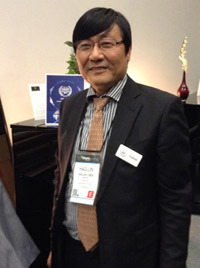
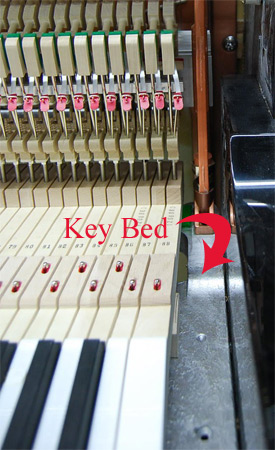 Earlier this year at NAMM I interacted with Mr. Hailun Chen – truly a privilege and honour to connect with such a humble visionary who has influenced and supplied more piano parts than we’re probably aware of. I greatly respect individuals who state “I have put my name on my pianos and on my company”. Mr. Hailun Chen is the real McCoy where his name is his guarantee.
Earlier this year at NAMM I interacted with Mr. Hailun Chen – truly a privilege and honour to connect with such a humble visionary who has influenced and supplied more piano parts than we’re probably aware of. I greatly respect individuals who state “I have put my name on my pianos and on my company”. Mr. Hailun Chen is the real McCoy where his name is his guarantee.
Working with a translator, he showed me different concepts in his pianos. What caught my eye was this silver looking gleam under the keys on one of their upright pianos. As seen in the picture, the key “bed” is the horizontal frame that the keys rest on. It’s imperative to have a solid key bed without which the piano touch would be compromised in evenness and functionality. Normally made out of wood, frames will sag or warp over time. It’s a common problem.
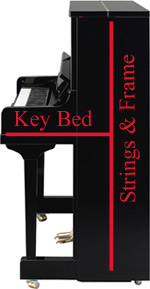 Aluminum however, prevents this problem and ensures both structural integrity but also alignment for a life-time. It is completely warp resistant. So if the strings run vertically in an upright piano, the key bed is perpendicular to the frame. If there is any sagging or warping in a wooden key bed, even by a few millimetres (1/16th of an inch), the problem is compounded in the vertical alignment of the strings.
Aluminum however, prevents this problem and ensures both structural integrity but also alignment for a life-time. It is completely warp resistant. So if the strings run vertically in an upright piano, the key bed is perpendicular to the frame. If there is any sagging or warping in a wooden key bed, even by a few millimetres (1/16th of an inch), the problem is compounded in the vertical alignment of the strings.
So what are the implications of integrating aluminum? (See? I knew you would be as excited about this innovation as I am. This innovation BTW is exclusive to Hailun pianos and is officially called PAS system – Permanency- Accuracy- Stability). 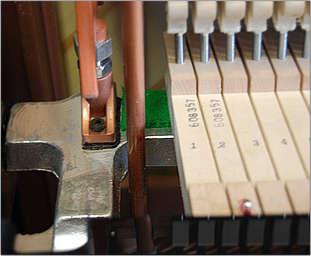 Well to keep any piano completely in ‘check’ and performing optimally, regulation (fine adjustments) are done. Quite often, as pianos age and get worn, piano technicians are making these adjustments to compensate for worn parts but also for a sagging key bed. What happens then if key bed issues were taken out of the equation? Indeed, the regulation would be a much easier task. Speaking with Basilios Strmec, CEO of Hailun Distribution for North America, it gets even better. Let’s say you are an avid pianist working hard on a performance degree and you used one of the Hailun pianos as a workhorse. You would expect to see substantial wear and tear, correct? Over years, when pianos start to feel and sound worn, if you had an aluminum key bed, you could simply swap actions and renew the instrument to its original condition.
Well to keep any piano completely in ‘check’ and performing optimally, regulation (fine adjustments) are done. Quite often, as pianos age and get worn, piano technicians are making these adjustments to compensate for worn parts but also for a sagging key bed. What happens then if key bed issues were taken out of the equation? Indeed, the regulation would be a much easier task. Speaking with Basilios Strmec, CEO of Hailun Distribution for North America, it gets even better. Let’s say you are an avid pianist working hard on a performance degree and you used one of the Hailun pianos as a workhorse. You would expect to see substantial wear and tear, correct? Over years, when pianos start to feel and sound worn, if you had an aluminum key bed, you could simply swap actions and renew the instrument to its original condition.
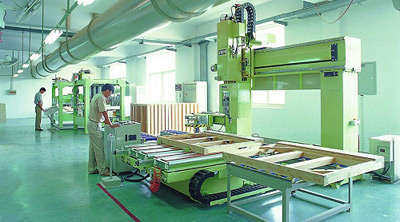
That means in essence you would have a mechanically NEW piano – with new joints, hammers and parts. It would feel new but also the fresh felt on the hammers would make it sound new. Historically during construction of a piano, one instrument’s parts were fitted to just one piano – meaning they’re not interchangeable.
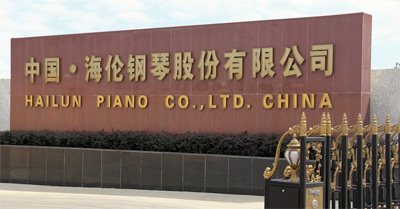
Even if it’s the same make, same model, same brand, same year, you would usually not be able to change out parts readily. With modern computer based CNC (Computer Numerically Controlled – in other words carving out parts by computer control), the precision is such that you could actually swap out the ‘engine’ of the piano with 4 bolts in a few minutes. In essence then, we’ve reached an age in manufacturing where not only are you investing in the present piano but saving on the rebuilding costs for years to come. That’s amazing! Kudos to Hailun for the innovation in the industry. Special thanks to Basilios Strmec for taking the time to discuss this with me and providing information.
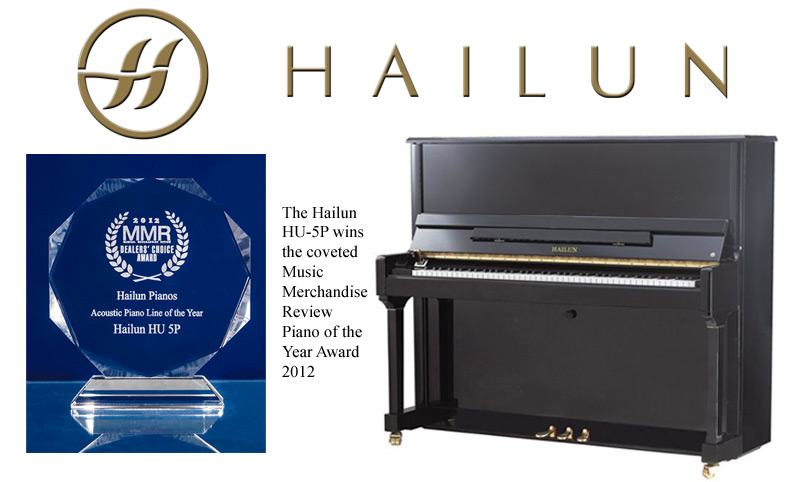
Haven’t heard of Hailun? They have over 430,000 square feet of manufacturing space and employ over 1,100 people and one of only 2 Chinese made piano companies listed on the Shenzhen stock exchange.
More Piano Articles

During the performance of Jacob Collier at the most recent NAMM show I was reminded that music makes us human, that beauty binds us together as a collective, and that the reason the music industry exists is to aid in the creation of art. I needed that reminder without which, the annual trade show featuring many of the great piano makers is just the sale of wares. I believe that people are feeling the uncertainty ...
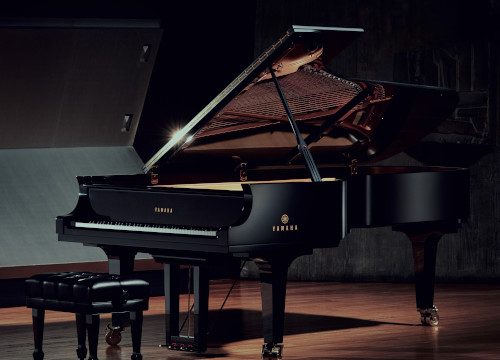
I used to have a teacher who would frequently say, “For every single grade point PAST 80%, it takes as much effort as the FIRST 80.” I believe this statement to be true from experience. The first 80 is the easiest. Chipping away at every point past that is the challenge. The bulk of the work can bring a project into shape but it’s the pursuit of excellence, that’s where the challenge lies. Yamaha is ...

The value of a piano is obvious ~ it’s the music that you make with it. But often, families are going through life changes which involve a house move and unfortunately, the piano needs to be sold. They invariably ask the question, “What are we going to do about the piano?” This question comes up because, as you can imagine, they’re not easy to move. We don’t simply pack them away in a cardboard box ...

You’ve been playing your piano for years now and the time has come to seriously consider downsizing the house and move into a condo. But what do you do with the piano? You love your piano and can’t imagine life without it and besides, you absolutely hate the idea of playing a digital keyboard. Many people don’t know that you can add digital functionality without compromising your existing piano. Yes, it is completely possible to ...
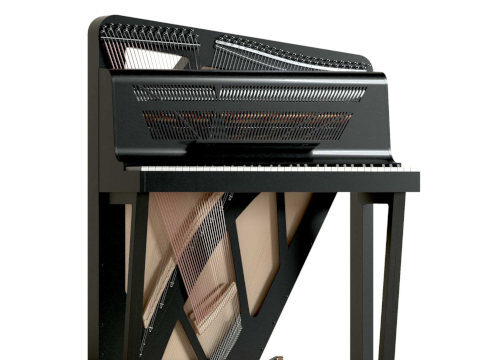
Many years ago, I remember seeing a piano in a museum similar to the one shown above (built in 1787 by Christian Gottlob Hubert. On display at Germanisches Nationalmuseum - Nuremberg, Germany). I have often wondered why acoustic portable pianos never really took off. Although we've seen more portable keyboard instruments like harpsichords, accordions or electronic keyboards, they operate completely different from a traditional piano in that they either pluck the strings, use air with ...
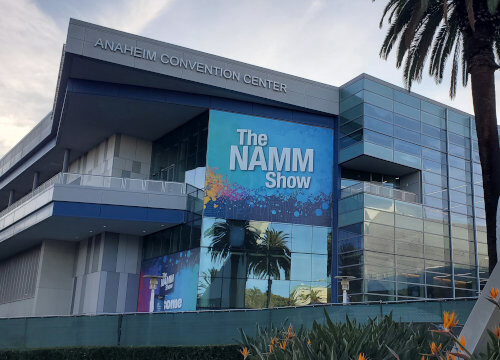
This was the first year since covid that the National Association of Music Merchants (NAMM) trade show was back to its regular January date and, in fact the first show where it felt back to normal. How was it? To answer that, I'm going quickly review the piano market over the last few years. Piano sales boomed during covid. Think about it - everyone was at home and with time on their hands, many turned ...